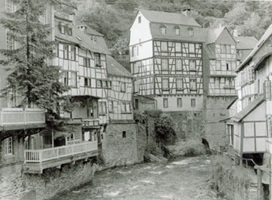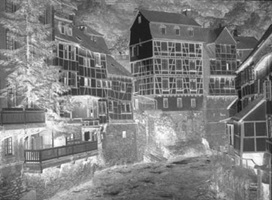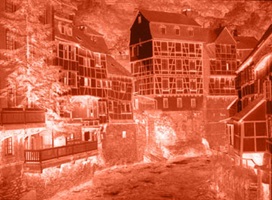|
By Ernest J. Theisen |
|
I make enlarged negatives for making my oil and bromoil transfer prints. I do this because I sometimes want to make more than one print from a negative this saves me the trouble of trying to dodge and burn each print the same way over and over. I do all that work on a big negative and use the negative to make contact prints. Before I go any farther let me mention excellent book on this subject; "Making Digital Negatives for Contact Printing" by Dan Burkholder. The book has complete instructions on how to do what I am describing here. |
by Ernest J. Theisen |
|
|
I use a Macintosh G3 computer, Agfa ArcusII scanner and an Epson 800 printer and of course Photoshop. I am using 5.0. The key to this process is the Epson ink jet printer. Epson uses what they call "Dry ink technology". The ink and the ability to print something in the area of 1440 dots per inch makes it possible to produce an very good enlarged negative right at your desktop. I have an Epson 800, a year ago it was state of the art, now their new printers are much better. However an 800 or 850 work just fine and you can find them used for less than $200. |
 |
|
|
In order to get the Epson to print at 1440 dpi on transparency material you have to "fool" the printer by telling it that you are printing on "Photo Glossy Inkjet paper". It works just fine. My scanner has a transparency adapter so I can start from a slide, an original negative or a positive. I still favor making a silver bromide positive, doing all the things we have always done to get a print we are satisfied with, and using that as my starting point. However, I have had good success using a 2 1/4" and 35mm negative as the input media. |
 |
|
|
I scan the image into photoshop and using cropping, dodge,
burn, levels etc. I arrive at a positive image that I am happy
with. I invert the image, making it a negative, colorize it and
print it on Epson transparency material. I have tried other materials
but the Epson material gives me the best negatives. The Epson
material is the only one that works well with an Epson printer. I use "levels" instead of "curves". Burkholder uses "curves" for his Platinum prints; I don't find that necessary. Burkholder put a little comment to that effect in his latest revision of his book; see page 196/197. |
 |
|
|
"Colorizing" the negative image overcomes one of the problems with transparency material. Transparency material is a clear plastic material that has been coated with a sticky substance that will allow the water based ink jet ink to stick to the plastic. If you print using black ink to make the transparency negative the black ink can puddle up in the dense highlight areas so sometimes you will get less than perfect gradation in the highlights. A colorized negative has been converted to "safelight" color so you don't need dense black ink to develop the highlights. There are three jpeg images with this file; a b&w positive, a b&w negative and a colorized negative. Some day this will become a bromiol and I will post that as well. These negatives work well for me on gum bichromate, casein bichromate, oil and bromoil prints. I have not used this method to make platinum/palladium prints. Good Luck |
||